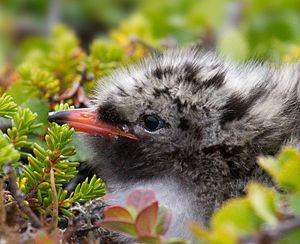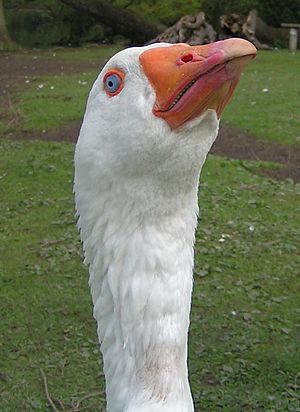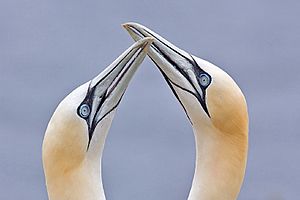Beak facts for kids
A beak is the mouth and nose of a bird. Birds use their beaks for many important things. They eat with them, groom their feathers, build nests, fight, and even feed their babies. Beaks come in all sorts of shapes, sizes, and colors, depending on what the bird needs to do.
A bird's beak is made of two main parts: an upper and a lower part, called mandibles. These are covered by a thin, tough layer, like your fingernails. Most birds also have two small holes called nares, which are like nostrils, for breathing.
Contents
What is a Beak Made Of?
A bird's beak might look simple, but it's quite complex! It has a bony core covered by a thin, hard layer called the rhamphotheca. This outer layer is made of keratin, the same material as your hair and nails. It grows continuously, just like your nails do.
Upper and Lower Parts
The beak has an upper part, called the upper mandible, and a lower part, called the lower mandible. These bony parts are strong but also light, which helps birds fly. The upper part can often move a little, which helps birds grab and manipulate things.
The Outer Covering
The rhamphotheca is the tough, outer skin of the beak. It's like a protective glove over the bones. This covering grows from the base of the beak. In some birds, like puffins, parts of this covering can even be shed each year after the breeding season!
Cutting Edges (Tomia)
The edges of a bird's beak are called the tomia. These are the parts that do the cutting and gripping.
- Some birds, like seed-eaters, have ridges on their tomia to help them crack open seeds.
- Falcons have a sharp "tooth" on their upper beak to help them kill prey quickly.
- Fish-eating birds, like mergansers, have saw-like edges to help them hold onto slippery fish.
- Some insect-eating birds have tiny bristles along their tomia. These bristles might help them hold onto hard-shelled insects.
Top Ridge (Culmen)
The culmen is the ridge along the top of the upper beak. It runs from where the feathers start on the bird's forehead to the very tip of the beak. Scientists often measure the length of the culmen to study birds. The shape or color of the culmen can also help identify different bird species.
Bottom Ridge (Gonys)
The gonys is the ridge along the bottom of the lower beak. In some gulls, there's a small bump called the gonydeal angle. Many adult gulls have a reddish or orange spot on this bump. This spot is important because it tells baby gulls where to peck to get food from their parents!
Mouth Corners (Commissure and Gape)
The commissure is where the upper and lower parts of the beak meet when the beak is closed. The gape is the inside of a bird's open mouth.
- Young birds often have brightly colored gapes, sometimes with patterns. These bright colors might signal to their parents that they are healthy and ready for food.
- As young birds grow, the fleshy parts at the corners of their mouths (gape flanges) become less noticeable.
Nostrils (Nares)
Most birds have two holes called nares (nostrils) on their beak. These lead to the bird's breathing system.
- Usually, nares are at the base of the upper beak. However, kiwis are special because their nares are at the very tip of their long beaks!
- Some birds, like cormorants, don't have external nares as adults and breathe through their mouths.
- Some birds, like ptarmigans, have feathers covering their nostrils to keep them warm. Woodpeckers have feathers to keep wood dust out.
- "Tubenoses" like albatrosses have nostrils enclosed in tubes on their beaks.
Nostril Covers (Operculum)
Some birds have a flap called an operculum that covers their nares.
- For diving birds, the operculum closes when they hit the water, keeping water out of their nasal passages.
- In pigeons, the operculum is a soft, swollen area at the base of the beak.
Waxy Base (Cere)
Some birds, like raptors (eagles, hawks), owls, and parrots, have a waxy area called a cere at the base of their beak. This area often contains the nostrils and can be brightly colored.
- In raptors, the cere's color can show how healthy a bird is.
- In some species, the cere's color can even tell you if a bird is male or female. For example, male budgerigars have blue ceres, while females have pinkish or brown ones.
Beak Tip (Nail)
Ducks, geese, and swans have a hard, shield-shaped plate called a nail at the very tip of their beak.
- They use this nail for different purposes, like digging for seeds in mud or prying mollusks off rocks.
- The nail also helps them grasp things firmly.
Stiff Feathers (Rictal Bristles)
Some birds have stiff, hair-like feathers called rictal bristles around the base of their beak.
- These are common in insect-eating birds.
- They might help birds catch flying insects, protect their eyes from debris, or even act like whiskers to help them feel things, especially in the dark.
Egg Tooth

When a baby bird is ready to hatch, it has a tiny, sharp bump on its beak called an egg tooth. This isn't a real tooth, but a special part of its beak that helps it break out of the egg.
- The chick uses its egg tooth to chip away at the eggshell, slowly making a hole big enough to escape.
- Most chicks lose their egg tooth a few days after hatching.
Beak Color
The color of a bird's beak comes from natural colors called pigments, like melanins (for grays and blacks) and carotenoids (for reds, oranges, and yellows).
- Beak colors are often brightest when birds are ready to breed.
- Birds can see ultraviolet (UV) light, and some birds have UV colors on their beaks. These UV spots can show how healthy a bird is or if it has a mate.
Different Beaks for Different Birds
Sometimes, male and female birds of the same species have different-sized or shaped beaks. This is called sexual dimorphism.
- For example, female shorebirds often have longer bills than males.
- The extinct huia bird had a very noticeable difference: the female's beak was long and curved, while the male's was shorter and straighter. This allowed them to find different types of food, so they didn't compete with each other.
How Birds Use Their Beaks
Defense
Birds can use their beaks to bite or stab if they feel threatened.
Communication
Some birds, like storks and owls, clap their beaks together to communicate with each other.
Staying Cool
Did you know some birds use their beaks to cool down? The toco toucan has a huge beak, and it can send more blood to it to release extra body heat, like an elephant uses its ears! Birds in colder places tend to have smaller beaks to prevent too much heat from escaping.
Billing
During courtship, many bird pairs touch or tap their beaks together. This behavior, called billing, helps them strengthen their bond as a couple. The way they do it varies: some gently touch, while others vigorously clatter their beaks.
Beak Trimming
Sometimes, in large poultry farms, a small part of a bird's beak is trimmed. This is done to prevent birds from hurting each other in crowded conditions, which can happen due to stress. This practice is carefully managed to reduce harm to the birds. For pet birds, a vet might trim a beak if it grows too long or has a problem, to help the bird eat and groom properly.
Bill Tip Organ
Some birds that search for food by poking their beaks into mud or soil have a special bill tip organ. This area at the tip of the beak has many nerve endings that can sense tiny movements, even if the bird doesn't directly touch the prey. This helps them find food hidden underground or underwater.
Images for kids
-
The platypus uses its bill to navigate underwater, detect food, and dig. The bill contains receptors that help detect prey.
-
Kiwis have a probing bill that allows them to detect motion
See also
 In Spanish: Pico (zoología) para niños
In Spanish: Pico (zoología) para niños






